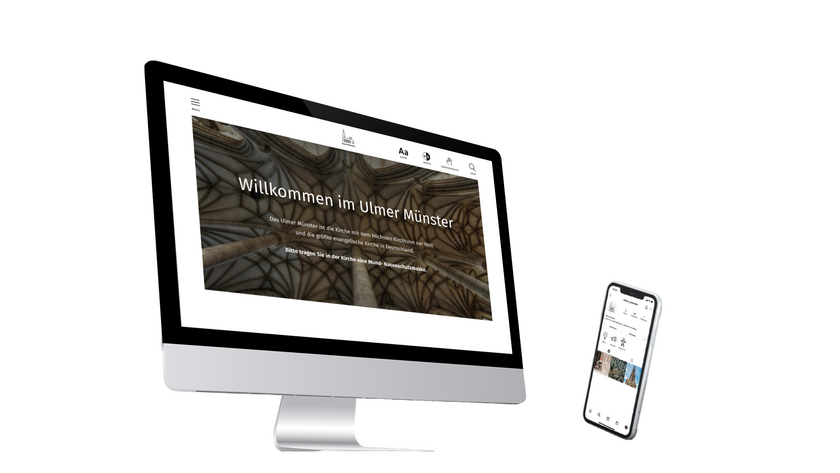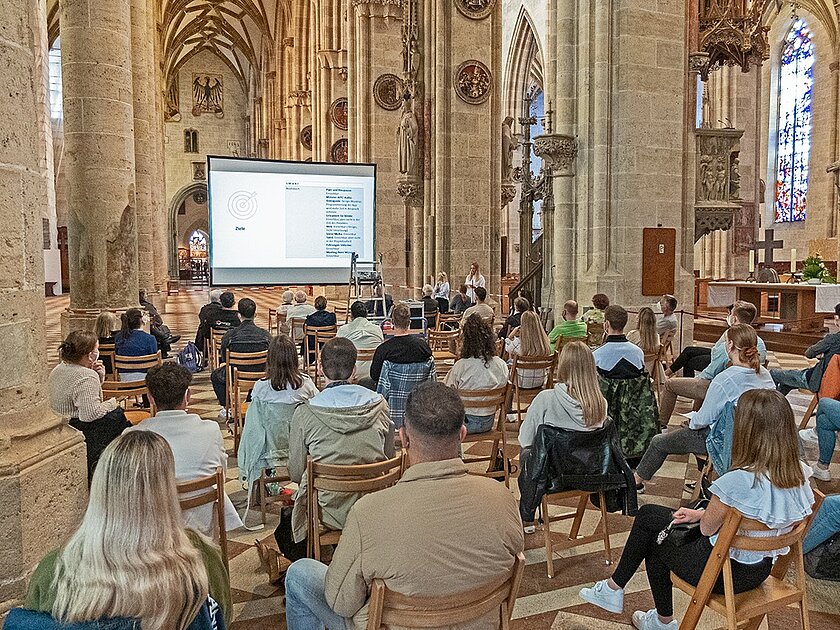Prof. Dr. Markus Caspers had given the IMUK students in the 5th semester the task of developing communication strategies for an inclusive experience of Ulm Cathedral The focus was on questions such as: "What ideas can we find for individual tools and measures and how can these be linked together?" and "How can the measures be communicated in their entirety?"
The students presented their results on 5 July 2021 in front of a full house or in a full church. Representatives of the cathedral parish, associations of those affected and the city dean Ernst-Wilhelm Gohl were present, as well as the cathedral architect Heidi Vormann and other interested parties.
The two students Fabian Girschick and Natty report on how they experienced the work for the communication project.
Extensive research for inclusive solutions
Together with five fellow students, Fabian Girschick worked for the "Research Team".
"For the past three and a half months, we have been working on how to make the Ulm region, and especially Ulm Cathedral, more accessible for people with disabilities. To do this, we not only researched on the internet and in scientific sources, but also conducted interviews with affected people. It was important for us to get to know their assessment of the situation in Ulm and the Ulm Cathedral in order to filter out possible problems.
One challenge was that we wanted to take other sights in Germany and all over Europe as an example for the accessibility of the Ulm Cathedral. To do this, we looked through their websites and information documents, but could find relatively little in the field of accessibility. This means that many sights still do not meet the requirements for barrier-free access. Ulm Cathedral could even become a pioneer in this respect.
We could gain a much better understanding of the perspective of disabled people. They are much more interested in being able to see themselves as part of the whole, rather than having new possibilities created especially for them. For example, all entrances to a tourist attraction should be barrier-free and there should no longer be just one entrance for disabled people. For the future, they hope that they will always be included in the decision-making process. Because a non-disabled person cannot make an assessment of whether something is really accessible or not."

Special design for special needs
Together with her team, Natty developed a concept for a mobile app that would provide an inclusive Münster experience for everyone through an audio / video guide. Thomas Reith, Managing Director at IT Engineering Reith, supported her with the concept.
"The basic identification of the problem and the creation of solution approaches presented the greatest difficulty in this project. It was important for us to correctly identify the challenges that people with an impairment face in their daily lives and then to find ways to specifically address these home challenges. In addition, we found it difficult to define the target groups we would focus on when developing the concept. However, we tried as best we could to cover all target groups (in our case: visually impaired, deaf and people without impairments).
Since we did not focus on just one target group, we also found it very difficult to create the concept for the app. We had to combine many ideas and make the app as simple as possible. Normally you would have to develop a separate app for all three target groups, but nevertheless we mastered these challenges relatively well and were able to combine it all in one app. The design for the app was also not easy. For example, visually impaired people need large buttons in the app and deaf people need icons or pictures to help them find their way around the app. Combining this in the design was another challenge for us.
Unfortunately, we only had a vague idea about the challenges people with an impairment face. Therefore, we are especially grateful that we were able to exchange ideas with those affected as well as with committed/involved people and thus gain insights and experiences that we would not have had under other circumstances.
Overall, this project has made us much more aware of the difficulties faced by people with disabilities, even in situations that seem completely normal to us. All of us agree that since this project we have a much better eye for inclusion. Whether in a restaurant or at the cinema, we now often think about whether it's a good idea to be inclusive."







